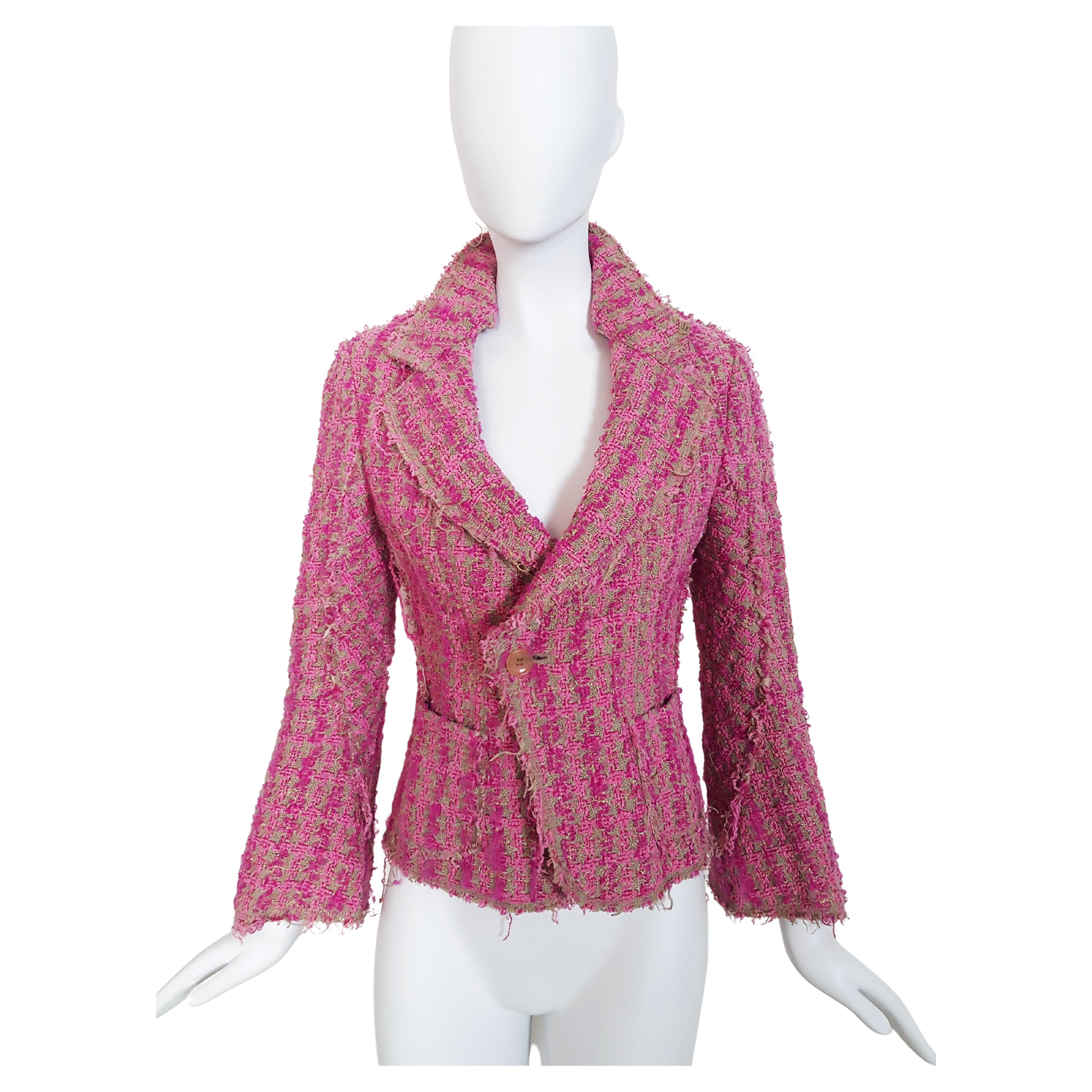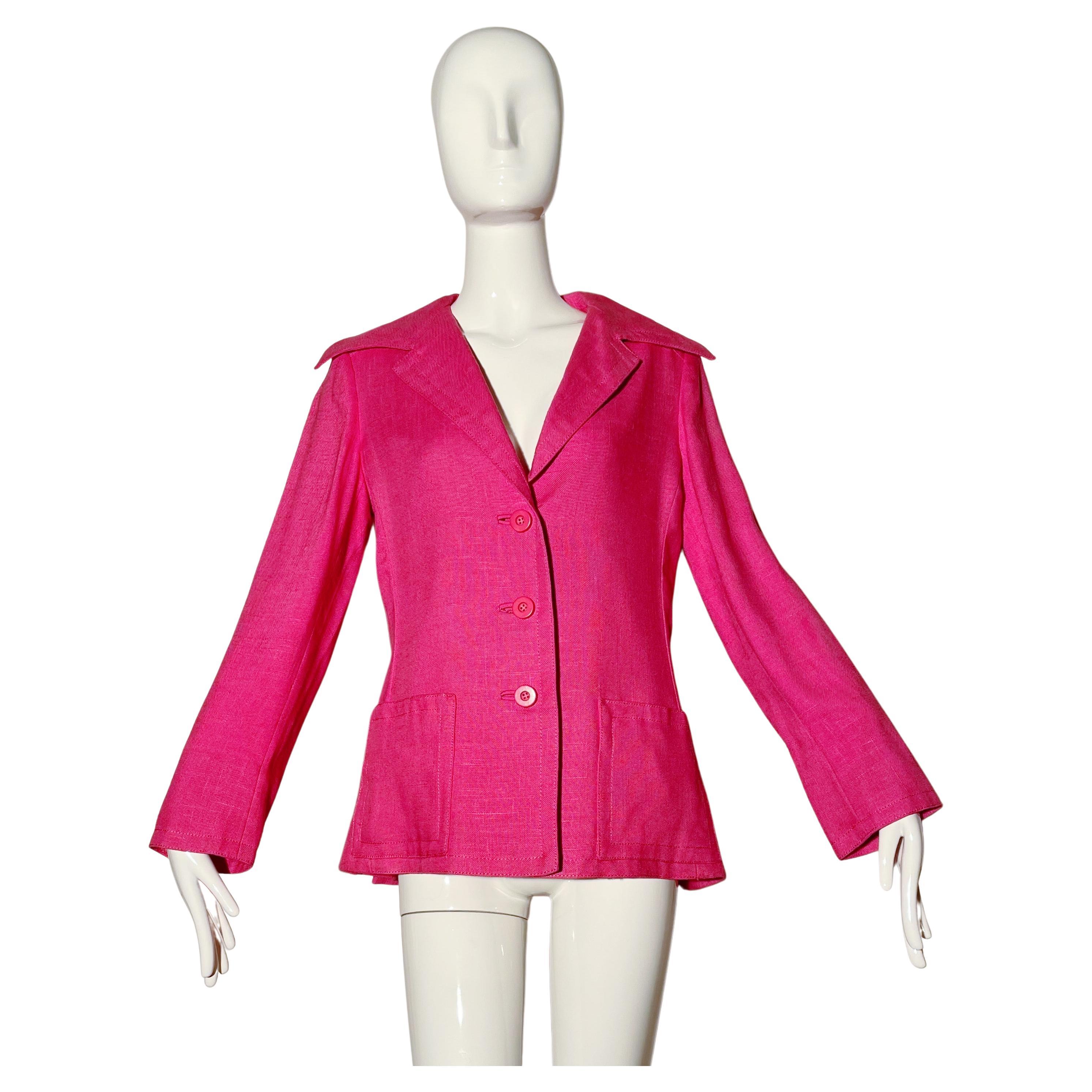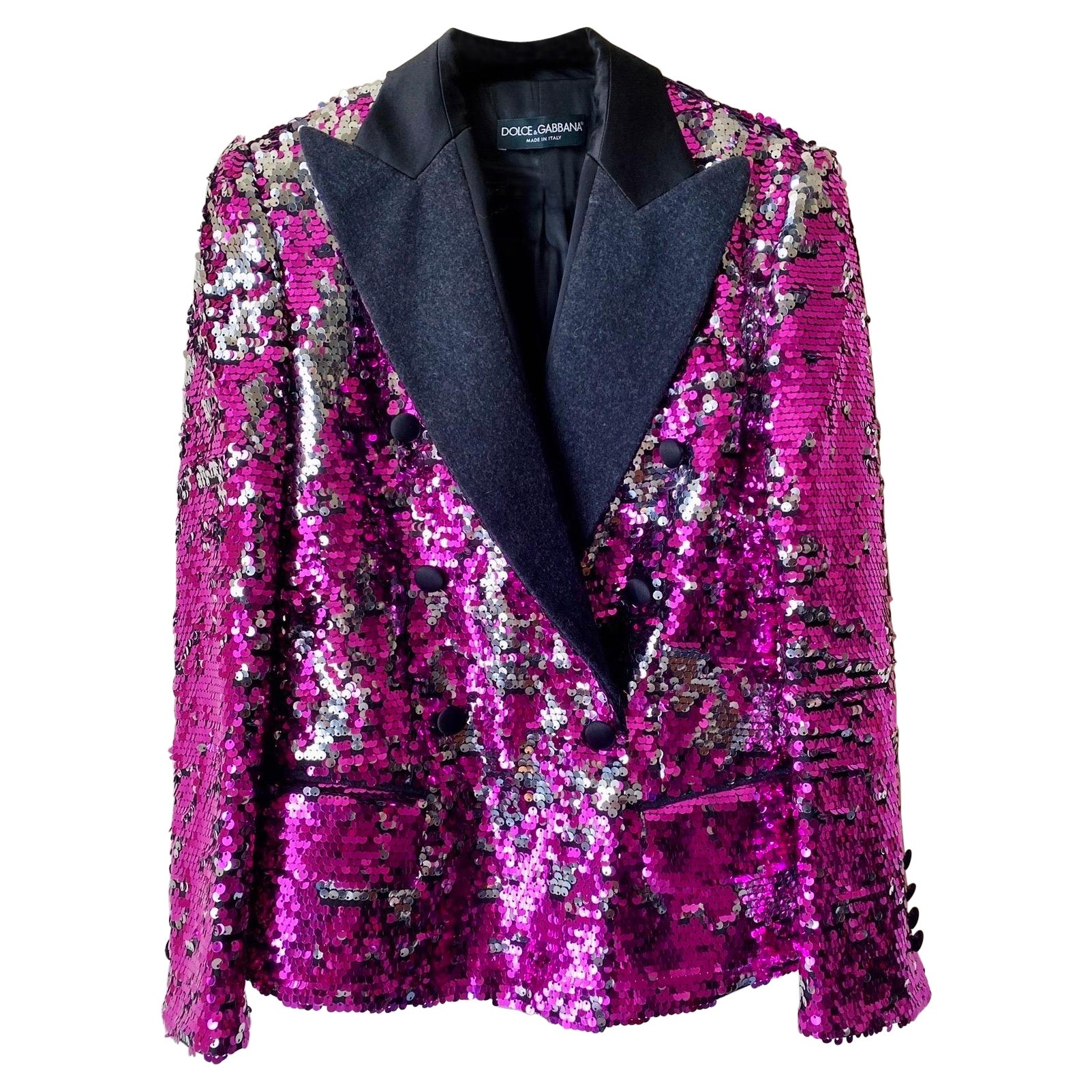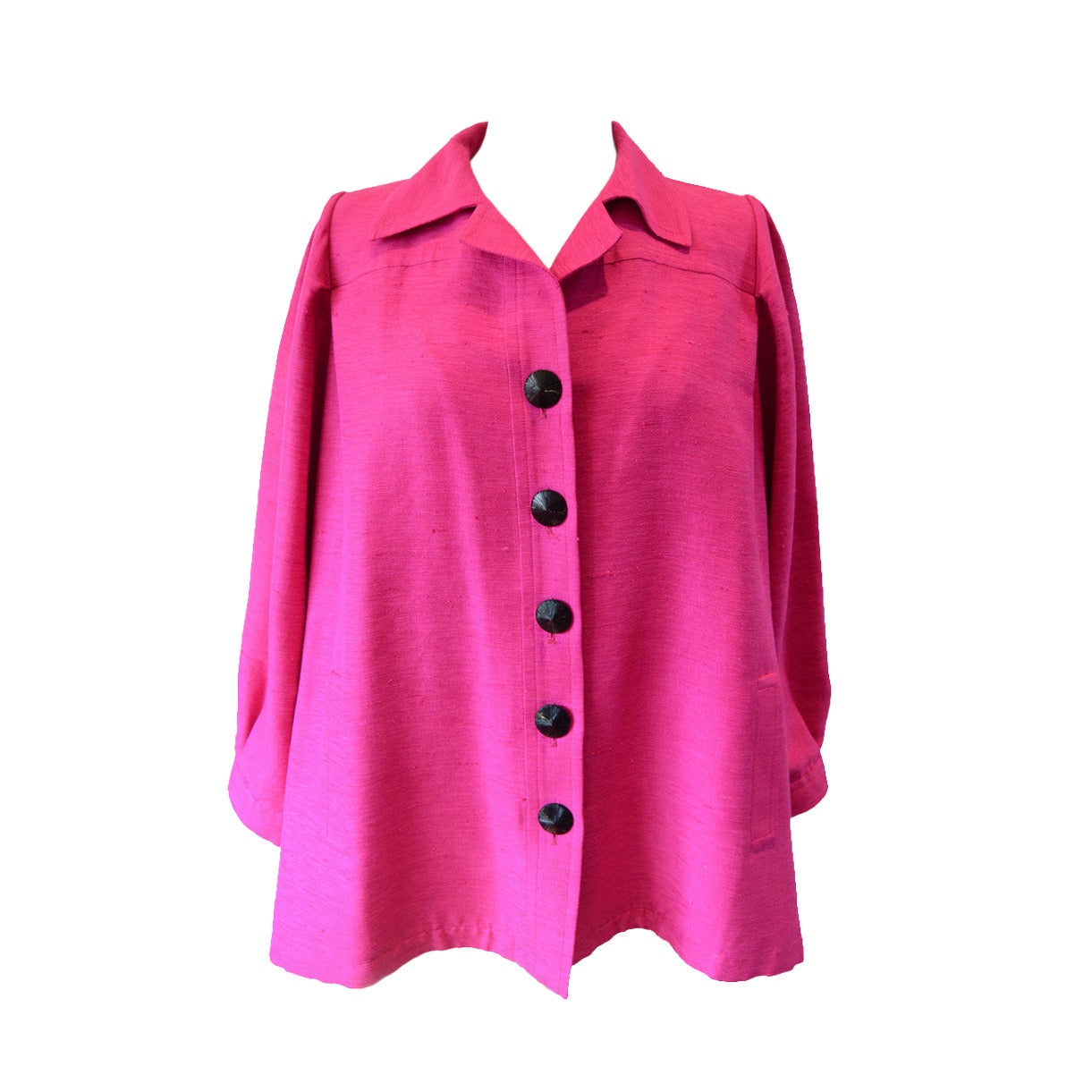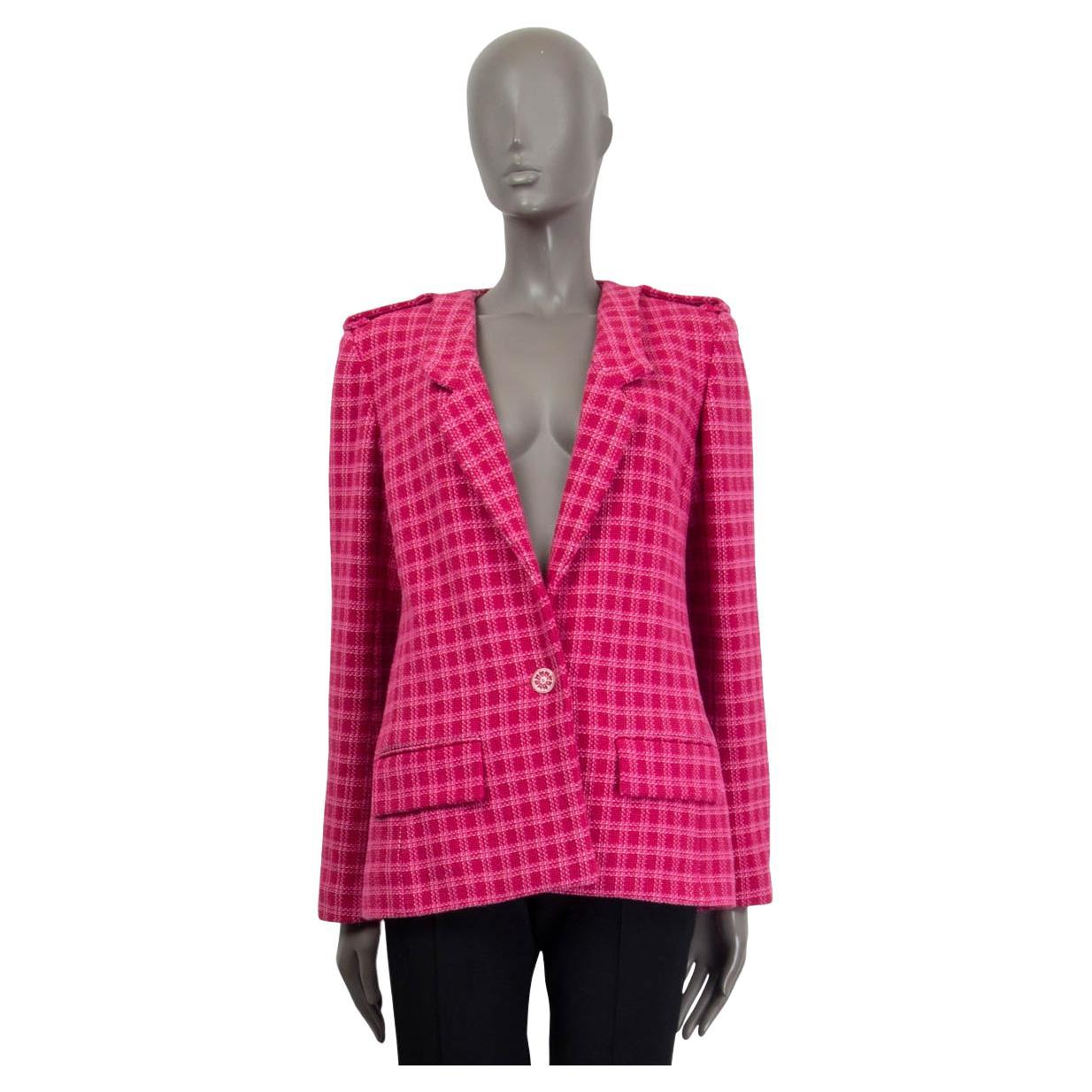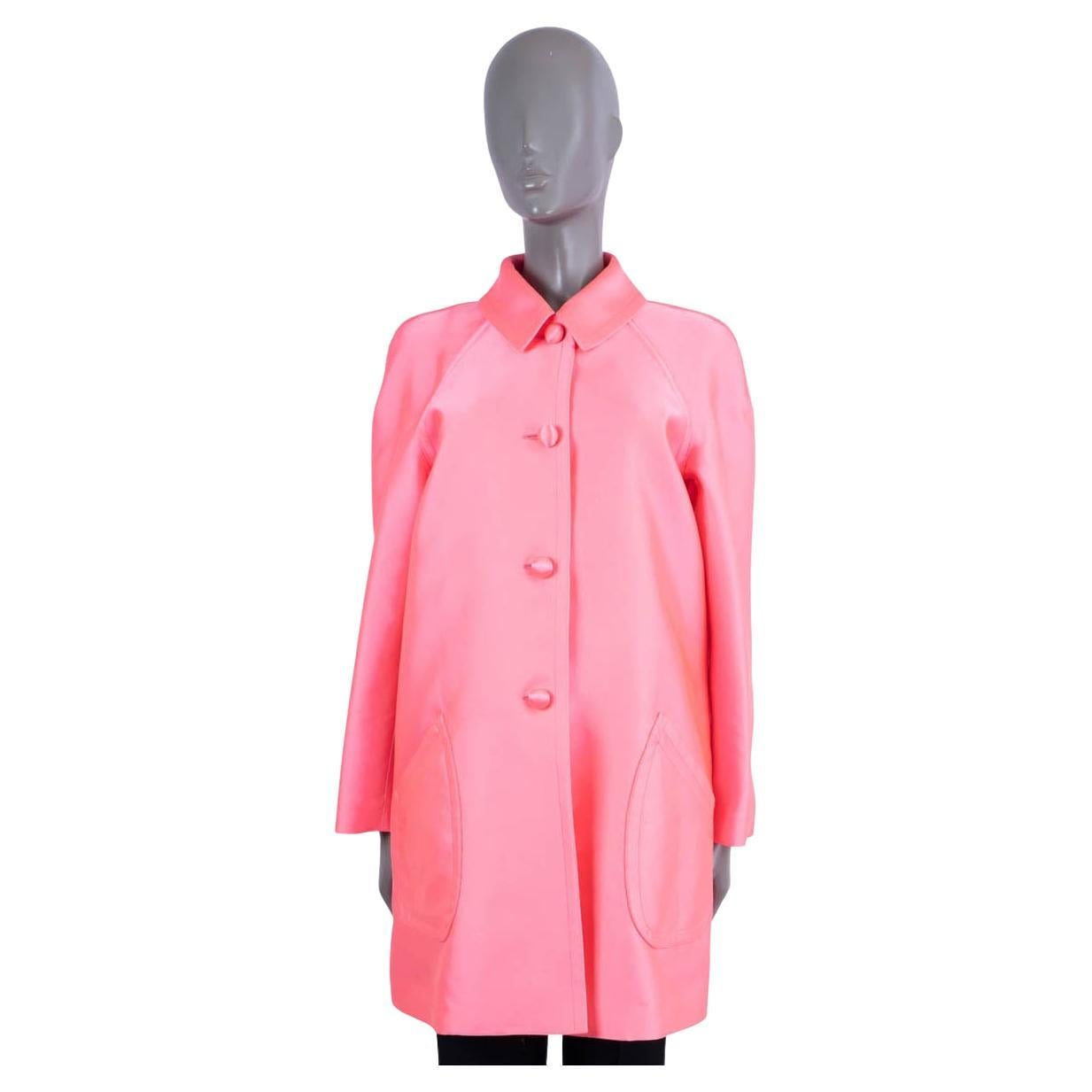Rare Mariano Fortuny Berry Silk Crepe Coat
About the Item
Venetian glass beads and silk cord are used to decorate the fabric edges and closures. There is one closure at the chest and one near the knees. Beads are used to weight the seams at the slashed armholes.
As renown specialists in Fortuny, Vintage Luxury is always interested in acquiring the finest examples of Fortuny including entire collections.
Fortuny translated the caftan as a loose fitting outer garment, usually made out of silk velvet crepe or gauze the fitted back and open front allowed for elaborate stenciled decoration and venetian bead trim.
This knee length silk crepe wrap, based on antique ethnic caftan styles, is cut square with openings for the arms. A stenciled Fortuny garment has minimal cuts so that the garment can serve as a canvas for the art work.
The hand stenciling is done with real gold metallic pigments aged to a mellow, burnished color. Fortuny built his stenciled pieces layer upon layer, until he achieved the effect of an ancient brocade.
Excellent condition.
Hand signed in side seam.
Dimensions:
Length: 38"
Width: 42"
- Designer:
- Place of Origin:
- Period:
- Material Notes:Silk Crepe, Venetian Glass beads
- Condition:Excellent.
- Seller Location:Riverdale, NY
- Reference Number:1stDibs: AAU09121546198D
Fortuny
Spanish fashion designer Mariano Fortuny was a true artist who worked with beautiful fabrics as his medium of choice. Although he showed talent in painting, sculpting, photography and architecture at an early age, fashion was where he really shined.
Fortuny was an innovator in the world of textile design, he drew on classical Greek tunics for his rich and interesting garments and worked with a revolutionary system for creating pleats. He designed a range of clothing for his couture house, and today, vintage Fortuny evening gowns, gemstone-colored day dresses, coats and accessories like drawstring bags are known for their fine craftsmanship and signature elegance.
Fortuny was born Mariano Fortuny y Madrazo in 1871 in Granada, into a family of artists. His father died when Fortuny was only three years old, and his mother moved the family to Paris. As a child, Fortuny was fond of experimenting and figuring out how things worked. He even dyed pieces of fabric from his family's textile collection, which had been amassed from shops around Europe.
In 1889, the family moved again, this time to Venice. Here, Fortuny found inspiration in the past, which would influence his future designs. Not long after, the young Fortuny set off to travel the continent. In 1897, he visited Paris and fell in love with a dressmaker named Henriette Negrin. She became his muse, his wife and his creative partner — Negrin worked with Fortuny on clothing designs and fabrics — and the two settled in the French capital.
A lifelong inventor, Fortuny began patenting his creations in 1901. By 1934, he had registered more than 20 patents. At the same time, his fashion career was taking off.
In 1907, he designed the Delphos gown with Negrin, which French novelist and essayist Marcel Proust described as "faithfully antique but markedly original." Fortuny had worked from his home until 1922 when increased demand required large-scale production. He opened a factory in Venice, where due to the scarcity of silk, he began experimenting with cotton.
In 1927, New York interior designer Elsie McNeill traveled to Paris to meet Fortuny and became his exclusive American distributor. She returned to the United States and introduced Fortuny's designs to New World audiences. Shops opened in Paris, New York and London. Toward the end of the 1930s, Fortuny returned to painting and stepped away from the busy fashion industry.
After Fortuny passed away in 1949, McNeill took over the label and continued running it until 1988, when it was purchased by the Riad family, who remain at the helm of Fortuny today.
On 1stDibs, find vintage Fortuny clothing and accessories.
- ShippingRetrieving quote...Ships From: Riverdale, NY
- Return PolicyThis item cannot be returned.
- Mariano Fortuny Burgundy Stencilled Crepe CoatBy FortunyLocated in Riverdale, NYFortuny translated the caftan as a loose fitting outer garment, usually made out of silk velvet crepe or gauze the fitted back and open front allowed for elaborate stenciled decorati...Category
Early 20th Century Italian Art Deco Coats
- Mariano Fortuny Claret Delphos. Provenance Tina ChowBy FortunyLocated in Riverdale, NYThis dress is made of finely pleated claret colored silk with silk cording along side seams, and multicolored glass beads threaded through the cording. The beads are amber glass with...Category
Early 20th Century Italian Art Deco Delphos Gowns
- Mariano Fortuny Sienna Peplos GownBy FortunyLocated in Riverdale, NYThis dress is made of finely pleated sienna colored silk with silk cording along side seams,shoulders and tunic hem with multicolored glass beads threaded through the cording.
...CategoryEarly 20th Century Italian Art Deco Peplos
- Mariano Fortuny Pink Stencilled Velvet Persian Style CoatBy FortunyLocated in Riverdale, NYthis three-quarter length orange-red cut velvet jacket was printed with metallic paints with Venetian glass buttons and silk loop closures at the center front.
The han...CategoryEarly 20th Century Italian Art Deco Coats
- Mariano Fortuny Black Silk Peplos GownBy FortunyLocated in Riverdale, NYThis dress is made of finely pleated black colored silk with silk cording along side seams,shoulders and tunic hem with matte frosted colored glass beads threaded through the cordin...Category
Early 20th Century Italian Art Deco Peplos
- Mariano Fortuny Amethyst Delphos GownBy FortunyLocated in Riverdale, NYThis dress is made of finely pleated amythest colored silk with silk cording along side seams, and multicolored glass beads threaded through the cording. Named after a Greek cla...Category
Early 20th Century Italian Art Deco Delphos Gowns
- JUNYA WATANABE POUR COMME DES GARÇONS pink tweed Jacket, c. 2000By Comme des Garçons, Junya Watanabe Comme des GarçonsLocated in Genève, CHJunya Watanabe x Comme des Garcons pink tweed jacket, beautifully made and structured (detailed sleeve ends, 2 frontal buttons to change fitting shape, collar, interior finishes...)....Category
Early 2000s Japanese Blazers
- Geoffrey Beene Pink Linen BlazerBy Geoffrey BeeneLocated in Los Angeles, CAPink blazer. Dramatic color. Front buttons. Front pockets. Linen. Lined. *Condition: Excellent vintage condition. No visible Flaws. Measurements Taken Laying Flat (inches)— Shoulde...Category
1970s Blazers
- Dolce & Gabbana runway 2011 pink sequined jacketBy Dolce & GabbanaLocated in PARIS, FRDolce & Gabbana runway Fall Winter 2011 pink sequined jacket as seen on Beyonce performing for the MTV awards in 2011, fits perfectly for a size 36 FR and 38 FR, it’s a size 38 IT ve...Category
2010s Jackets
- Yves Saint Laurent Vintage Pink Silk and Linen Faille JacketBy Yves Saint LaurentLocated in Philadelphia, PAVintage Yves Saint Laurent pink jacket in excellent condition. Pink woven silk and linen faille with 5 front black buttons. Two hand pockets. Unlined. Shoulder pads add structure and shape but can easily be removed. A line bottom hem. Original tag attached reads size 38. This piece is in excellent condition. No stains, smells or fabric pulls. From a smoke & pet free home. This is a beautiful vintage high...Category
1980s French Jackets
- CHANEL pink cotton 2016 SEOUL OVERSIZED TWEED Blazer Jacket 40 M 16CBy ChanelLocated in Zürich, CH100% authentic Chanel Cruise 2016 Seoul oversized one-button tweed blazer in pink cotton (92%) and acrylic (8%). Features epaulettes at the shoulder...Category
2010s Jackets
- CHRISTIAN DIOR neon pink polyester 2022 Coat Jacket 38 SBy Christian DiorLocated in Zürich, CH100% authentic Christian Dior coat in neon pink polyester (69%) and silk (31%). Features two front pockets and a slit on the back. Opens with four buttons on the front. Unlined. 2...Category
21st Century and Contemporary Jackets
